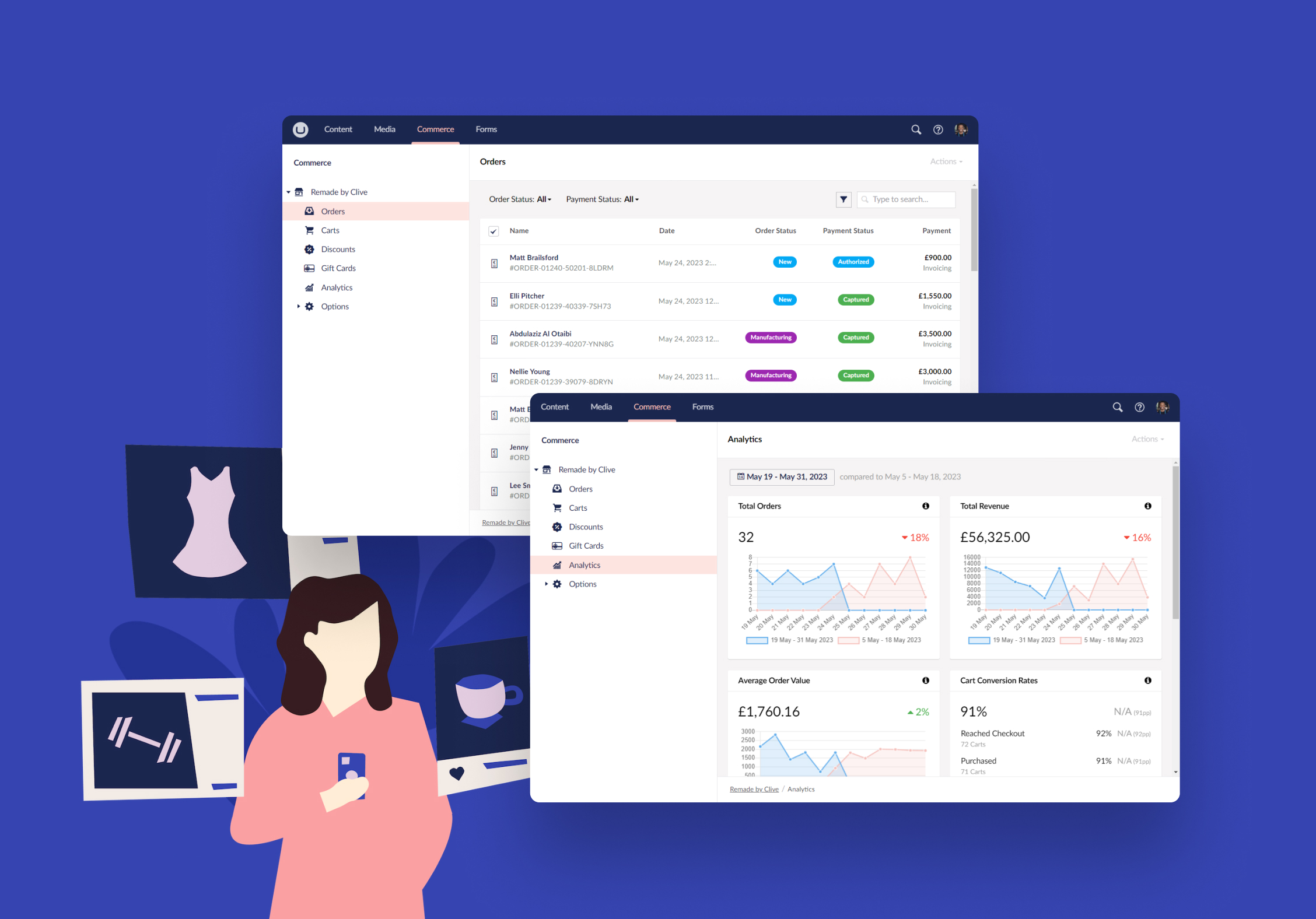It’s no secret that e-commerce sales are showing no signs of slowing down. Sales are growing by 39% annually, and experts reckon the global online retail market will reach a total of over $8.1 trillion by 2027.
That means more opportunities for businesses like yours, so choosing the right e-commerce platform is more important than ever.
While many platforms exist (from Squarespace and Wix to Magento and WooCommerce), in this post, we’re looking at two of the most popular - Umbraco Commerce and Shopify. We will explore their strengths, weaknesses and the key factors that should guide your decision.
From functionality, affordability and ease of use, to customisation and scalability, we dive into the details that set these platforms apart, so you can decide which fits your business best.
Umbraco Commerce: the pros and cons
Umbraco Commerce is an add-on for the Umbraco CMS, a popular .NET content-management system used by developers and agencies around the world. In simple terms, it lets you run a fully-fledged online shop right inside your website.
Because it’s built to be customised, it’s great if you need something that fits your business perfectly, rather than trying to squeeze your business into a one-size-fits-all platform.
Why people like it
-
It’s flexible. You can build the store exactly how you want it, perfect for businesses with unique products, complex pricing or multiple stores.
-
It plays nicely with content. If you already use Umbraco CMS, it’s a great fit, managing content and commerce from one dashboard.
-
No sneaky transaction fees. You pay for your licence and hosting, but Umbraco doesn’t take a cut of each sale.
-
Ready for global growth. It handles multiple languages and currencies without breaking a sweat.

The trade-offs
That flexibility comes at a cost, mainly time and technical know-how. You’ll need a developer (or an agency partner 👋) to set it up and maintain it. For smaller teams, that can feel like a lot.
And because it’s self-hosted, you’re responsible for updates, security and hosting. That gives you control, but also more to think about.
Key takeaway
If you want full control and you’ve got access to developer support, Umbraco Commerce is a solid, long-term choice that grows with you.
- Umbraco Commerce licences start from around $2,900 USD per year.
- Umbraco itself powers thousands of sites worldwide and has an active, friendly developer community.
- It’s used by businesses that want to blend content and commerce in one place, rather than bolt them together later.
Shopify: the pros and cons
Shopify is a hosted e-commerce platform that takes care of all the technical stuff for you, including hosting and updates to security and speed. You just log in, pick a theme, add your products, and start selling.
It’s designed to make running an online shop as straightforward as possible.

Why people like it
- No servers or security worries. Shopify hosts and maintains everything for you.
- Scalable infrastructure. Shopify handles spikes in traffic, global store capabilities, and multichannel selling (online, marketplaces, social) are built in.
- Lots of apps and themes. You can extend functionality quickly via plug-ins rather than always building custom.
- It’s good for smaller or medium-sized businesses that want to focus on trading rather than infrastructure or platform build.
The trade-offs
Shopify is super convenient, but it’s not as flexible as something like Umbraco Commerce. You’re working within their system, which can be great for some businesses, but not ideal if you have very specific needs.
And unless you use Shopify Payments, they’ll charge a small transaction fee on each sale. Those can add up if you’re processing a lot of orders.
Key takeaway
Shopify is a strong choice for businesses that want speed, ease of use, good-enough flexibility, and a robust ecosystem. For businesses with very specific/customised needs, you may need to evaluate whether it fully meets them without compromising or paying extra.
- Shopify now powers over 5.5 million stores worldwide.
- It holds around 10% of the global e-commerce platform market, and about 20% in the UK.
- Its revenue grew 26% year-on-year in 2024.
Factors influencing your decision
Here are key factors to consider when choosing between Umbraco Commerce and Shopify (or any platform). Tailor them to your business context, as there’s no “one-size-fits-all”.
1. Business size & growth ambition
If you’re a small/medium business looking to launch quickly, minimise tech overhead, and scale rapidly, Shopify is often a strong fit.
If you’re an enterprise or fast-growing business with complex needs (multisite, multilingual, multi-currency, headless, custom workflows), then Umbraco Commerce may offer the architectural flexibility you’ll need.
2. Budget & total cost of ownership
Shopify is typically a per-month subscription, plus the cost of themes/apps, plus transaction fees if you’re not using Shopify Payments. Budgeting is relatively predictable.
For Umbraco Commerce, you would need to consider the licence cost and hosting/infrastructure, plus implementation, development and ongoing maintenance. However, you may save on transaction fees and have more flexibility in long-term cost control.
Consider not just the initial “build” cost, but the ongoing “operate” costs like updates, scale, integrations, and platform enhancements.
3. Customisation & technical complexity
If your commerce model is mostly “standard” (product catalogue, cart, checkout, shipping, international shipping) and you value speed to market, less customisation may be required, so you may favour Shopify.
If you need deeply customised business logic (e.g., bespoke checkout flows, complex pricing logic, custom front-end experiences, content-led e-commerce, full API/SDK control), Umbraco Commerce gives more freedom.
Also, think about developer availability and in-house skills. Do you have a .NET/Umbraco development team? Or would you prefer minimal dev resource and use apps?
4. Global/local markets & localisation
Internationalisation is increasingly important (multi-currency, multi-language, local compliance, local payment methods).
Umbraco Commerce has the advantage of full control over localisation architecture (particularly if you’re already using Umbraco CMS for your content).
Shopify supports global stores, but various region-specific features/costs may apply, check local payment gateways, cross-border shipping, and localisation of apps/themes.
5. Ecosystem, integrations & future-proofing
Shopify benefits from a large third-party app ecosystem, including marketing tools, analytics, POS, marketplaces, subscriptions, etc.
Umbraco Commerce may require more custom integrations, but it gives you the freedom to choose or build best-of-breed components.
Consider roadmap & future trends. For example, the move towards composable architecture (CMS + PIM + CDP + commerce) and AI-driven personalisation. (Umbraco itself has published predictions around this).
Think about vendor lock-in, upgrade path, scalability and how the platform will serve you in 3-5 years, not just now.
6. Speed to market vs long-term flexibility
Shopify’s advantage is fast launch, fewer infrastructure worries, and broad app support, which is good for launching or testing quickly.
Umbraco Commerce’s advantage is more build time, more upfront cost, but long-term flexibility for tailored experiences.
If you need to move fast, test, iterate, maybe pick Shopify; if you’re building a “digital experience platform” where commerce is deeply integrated with content, lean towards Umbraco Commerce.
7. Maintenance, upgrades, support and security
For SaaS (Shopify): platform upgrades/security patches are handled by the vendor; you worry about store content/apps.
For self-hosted/custom (Umbraco Commerce): you’ll have to manage infrastructure, security, updates, but you also control when/how.
Make sure you have reliable agency or internal team support for whichever you pick.
Future trends & what to watch out for
E-commerce is changing fast. Over the next few years, we’ll see more businesses:
- Using AI tools to personalise shopping experiences and automate marketing.
- Moving towards composable setups, mixing and matching the best CMS, commerce and data tools rather than using one all-in-one platform.
- Focusing on sustainability and transparent supply chains.
Both Umbraco Commerce and Shopify are keeping pace, but think about where your business will be in three years, not just where it is today.
Real-world experience
We’ve seen first-hand how different platforms can deliver exceptional results when used in the right way.
As an Umbraco Gold Partner, we’ve built over 250 digital experiences since we started out in 2008. We’ve delivered Umbraco Commerce implementations for brands including Sherwin-Williams (Valspar, V&CO), the Commonwealth War Graves Commission (CWGC) and Camira Fabrics, each tailored to meet unique business needs and scale for international audiences.
We’ve also taken a composable architecture approach on other projects, integrating Shopify as the e-commerce engine with Umbraco providing content as a service via the Storefront API and Next.js, most notably for the House of Rohl.
This approach brings the best of both worlds - the extensibility and open-source flexibility of Umbraco, combined with the robust e-commerce capabilities and rich app ecosystem of Shopify.
It’s a perfect example of how, with the right strategy and technical expertise, businesses don’t always have to choose either/or, sometimes, the answer is both.
Final thoughts
The choice between Umbraco Commerce and Shopify isn’t just a technology decision; it’s a business decision that hinges on your ambitions, resources, timelines and team competencies.
If you pick Shopify, you’ll trade some flexibility for speed and simplicity, which may be entirely right for your business.
If you pick Umbraco Commerce, you’ll invest more upfront (time, resource, cost) for a platform with deeper potential to integrate, customise and scale as part of a wider digital experience ecosystem.
Check out our digital experience services and get in touch to chat through your options.

Ready. Steady. Grow!
We've helped some of the world's biggest brands transform and grow their businesses. And yours could be next.
So if you've got a business challenge to solve or a brief to answer, we'd love to hear from you. Simply complete this form and one of our experts will be in touch!




